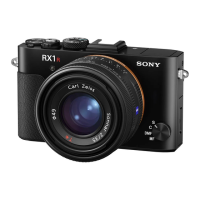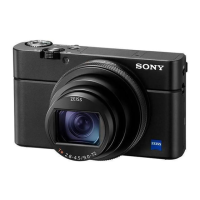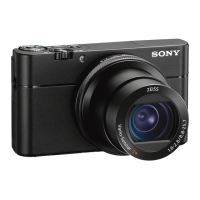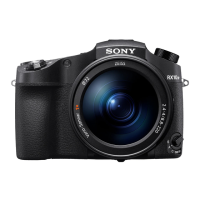
Do you have a question about the Sony DSC-RX100M5 and is the answer not in the manual?
| Image Processor | BIONZ X |
|---|---|
| Lens Type | Zeiss Vario-Sonnar T* |
| Optical Zoom | 2.9x |
| Continuous Shooting | 24 fps |
| Max Video Resolution | 4K (3840 x 2160) |
| Battery | NP-BX1 |
| Dimensions | 101.6 x 58.1 x 41.0 mm |
| Connectivity | Wi-Fi, NFC |
| Sensor Type | Exmor RS CMOS sensor |
| Effective Pixels | 20.1 megapixels |
| Focal Length | 24-70 mm |
| Aperture Range | f/1.8 - f/2.8 |
| ISO Sensitivity | 125-12800 (expandable to 25600) |
| Shutter Speed | 1/2000s to 30s |
| LCD Screen | 3.0-inch LCD, tiltable |
| Viewfinder | 0.39-inch OLED (2, 359, 296 dots) |
| Battery Life | Approx. 220 shots |
| Weight | 299 g |
| Autofocus Points | 315 points |
Identifies all external buttons, dials, and components of the camera.
Explains the meaning of symbols and indicators displayed on the screen.
Instructions on how to attach and use the camera wrist and shoulder straps.
Guide to adjusting the diopter for clear viewfinder images based on eyesight.
Accessing and using the camera's built-in help system for features and settings.
Details on how to charge the camera's battery pack using various methods.
Instructions for inserting and removing memory cards from the camera.
Guide to configuring initial camera settings like language and time.
Explains how to navigate menus and select options using the control wheel.
Details on utilizing the control ring for quick setting adjustments.
How to access and navigate the camera's main menu system.
Customizing and using the Fn button for quick access to frequently used functions.
Operating camera settings directly from the Quick Navi screen.
Basic steps for capturing still photographs with the camera.
Instructions on how to record movies using the camera's movie function.
Overview of the different shooting modes available on the mode dial.
Using the camera's fully automatic mode with scene recognition.
Utilizing Superior Auto mode for enhanced automatic shooting in challenging conditions.
Explains how the camera automatically recognizes and adapts to different scenes.
Highlights the benefits of using automatic shooting modes for ease of use.
Using Program Auto mode for automatic exposure with manual control over other settings.
Capturing wide panoramic images by panning the camera.
Using preset scene modes optimized for specific shooting situations.
Manually setting shutter speed to control motion blur in shots.
Manually setting aperture to control depth of field and background blur.
Full manual control over exposure settings for creative control.
Using BULB mode for long exposures, ideal for capturing light trails.
Recalling previously saved custom shooting settings.
Accessing settings specifically for recording video footage.
Capturing high frame rate movies for dramatic slow-motion playback.
Exploring the various zoom capabilities and settings of the camera.
Instructions and settings for using the built-in camera flash.
Important considerations and tips for effective flash photography.
Selecting different flash modes like Auto, Fill-flash, or Slow Sync.
Adjusting the intensity of the flash output for proper exposure.
Customizing the information shown on the shooting screen display.
Managing display output between the electronic viewfinder and the LCD screen.
Configuring display options specifically for the viewfinder.
Configuring display options specifically for the LCD monitor.
Displaying Time Code and User Bit information during movie recording.
Choosing the resolution and pixel dimensions for still photographs.
Setting the aspect ratio (e.g., 3:2, 4:3, 16:9) for still images.
Selecting the image compression quality (RAW, Extra Fine, Fine, Standard).
Adjusting the image size when shooting panoramic photos.
Setting the direction for panning the camera when capturing panoramas.
Selecting autofocus modes like Single-shot AF or Continuous AF.
Choosing the specific area of the frame for autofocus.
Explains the use of phase detection AF technology for faster focusing.
Utilizing AF that locks onto a subject centered in the frame.
Setting whether the focus area display disappears automatically.
Locking focus on a subject for recomposing shots.
Manually adjusting focus using the control ring for precise control.
Combining autofocus with manual focus adjustments for fine-tuning.
Using image magnification to aid manual focusing.
Enlarging the image on screen to check focus before shooting.
Adjusting overall image brightness to make it brighter or darker.
Selecting how the camera measures light for exposure calculation.
Locking exposure settings to maintain consistent brightness.
Fixing exposure automatically when the shutter button is pressed halfway.
Using zebra patterns to visualize overexposed areas for brightness adjustment.
Displaying a guide to help adjust exposure settings.
Setting the shooting interval for continuous or self-timer modes.
Capturing a rapid sequence of images by holding the shutter button.
Using a delay timer for shooting to avoid camera shake or include the photographer.
Setting a self-timer to capture multiple shots with a delay.
Shooting multiple frames with varying exposure levels automatically.
Shooting multiple frames with exposure variations, requiring manual shutter press for each.
Shooting multiple frames with different white balance settings automatically.
Adjusting the camera's sensitivity to light (ISO) for exposure control.
Setting the minimum shutter speed before ISO sensitivity starts changing automatically.
Combining multiple shots to reduce noise and improve image quality.
Adjusting the level of noise reduction applied in Multi Frame NR.
Optimizing image contrast and brightness by analyzing light and shadow.
Capturing images with a wider dynamic range by combining multiple exposures.
Setting the camera's white balance to match ambient lighting conditions.
Manually setting a custom white balance based on a white reference.
Applying artistic filters and creative effects to images.
Selecting predefined image processing styles for desired visual output.
Overview of the different video file formats supported by the camera.
Selecting the primary file format for movie recording (XAVC S, AVCHD, MP4).
Choosing resolution, frame rate, and bit rate for movie recordings.
Simultaneously recording movies in two different formats.
Saving and recalling frequently used camera settings.
Assigning functions to the Fn button for quick access.
Customizing the function of various physical buttons on the camera.
Assigning specific functions to the control ring for easier operation.
Assigning custom functions to the C (Custom) button.
Assigning custom functions to the center button.
Assigning custom functions to the left directional button.
Assigning custom functions to the right directional button.
Assigning a function to the Send to Smartphone button.
Intuitively adjusting settings for shooting with a special screen display.
Enabling automatic face and smile detection for shooting.
Applying a smoothing effect to skin tones in portraits.
Registering faces for priority detection in Smile/Face Detect.
Minimizing red-eye effect in flash photos.
Automatically trimming images to improve composition after shooting.
Enabling or disabling image stabilization for still photos.
Reducing noise during long exposure shots.
Reducing noise in images shot at high ISO sensitivities.
Steps to view recorded still images in playback mode.
Enlarging specific areas of a playback image for detailed viewing.
Displaying multiple images simultaneously in a grid format.
Changing the information displayed during image playback.
Options for deleting single or multiple selected images.
Steps for playing back recorded movie files.
Viewing captured panoramic photographs.
Specifying images for printing and setting print options.
Utilizing various functions for enhanced image viewing and management.
Connecting the camera to a TV for image playback.
Accessing and configuring various camera settings via the setup menu.
Adjusting the brightness of the camera's LCD screen.
Adjusting the brightness of the electronic viewfinder.
Adjusting the color temperature of the electronic viewfinder.
Assisting contrast monitoring for S-Log movies during shooting.
Setting whether to turn off power when the viewfinder is stowed.
Setting the sound volume for movie playback.
Controlling whether the camera produces operational sounds.
Configuring automatic image uploads using an Eye-Fi card.
Establishing a connection between the camera and a smartphone.
Using the PlayMemories Mobile app for smartphone connectivity.
Connecting an Android device via QR code for wireless transfer.
Connecting an iPhone/iPad via QR code for wireless transfer.
Connecting an Android device manually via SSID and password.
Connecting an iPhone/iPad manually via SSID and password.
Launching apps via NFC touch connection with compatible smartphones.
Using a smartphone as a remote controller for shooting.
Connecting via NFC for remote operation with a smartphone.
Transferring selected images wirelessly to a smartphone.
Sending images wirelessly to Android device via NFC.
Transferring images wirelessly to a computer for backup.
Viewing images on a network-enabled TV.
Temporarily disabling all wireless functions, useful during flights.
Easily registering an access point using WPS button.
Manually registering an access point by entering SSID and password.
Changing the device name for Wi-Fi Direct connections.
Displays the product's MAC address for network identification.
Resetting Wi-Fi connection information for pairing new devices.
Resets all network settings to their default values.
Accessing and managing downloadable camera applications.
Information on recommended computer specifications for software.
Procedures for installing applications onto the camera.
Steps to download and install applications from the website.
Downloading applications wirelessly without a computer connection.
Opening applications that have been downloaded to the camera.
Removing installed applications from the camera.
Rearranging the display order of installed applications.
Viewing account details for PlayMemories Camera Apps.
Information on recommended computer specifications for software.
Details on using associated software like PlayMemories Home.
Overview of PlayMemories Home features for image management.
Steps to download and install the PlayMemories Home software.
Information on using software with Mac computers.
Using Image Data Converter for RAW image processing.
Steps to download and install the Image Data Converter software.
Accessing the help documentation for Image Data Converter.
Using your computer to control camera settings and shooting.
Steps to download and install Remote Camera Control software.
Accessing the help documentation for Remote Camera Control.
Establishing a USB connection between the camera and a computer.
Transferring images from the camera to the computer.
Safely removing the USB connection between the camera and computer.
Choosing the disc type (Blu-ray, DVD) for movie creation.
Creating Blu-ray discs from HD movies using software.
Creating AVCHD DVD discs from HD movies.
Creating standard definition DVD discs from HD movies.
General precautions for product usage, handling, and storage.
Information about the camera's internal backup battery for settings.
Important notes regarding battery charging, usage, and maintenance.
Important notes regarding memory card handling, compatibility, and usage.
Instructions for cleaning the camera's exterior, lens, and flash.
Estimates for image count and movie recording time based on memory card size.
Information on using the product internationally, including power adapters.
Guidance on TV color system compatibility for viewing movies.
Additional details including lens specifications and format information.
General guidance on how to approach product issues.
Specific solutions for common product problems and errors.
Troubleshooting steps related to battery issues and power supply.
Solutions for common problems encountered during still image and movie capture.
Troubleshooting steps for issues related to image playback.
Solutions for problems encountered with Wi-Fi connectivity.
Troubleshooting steps for issues when connecting to computers.
Solutions for problems related to memory card usage and compatibility.
Troubleshooting steps for issues encountered during image printing.
Solutions for miscellaneous product issues not covered elsewhere.
Explanation of self-diagnosis and warning messages displayed by the camera.












